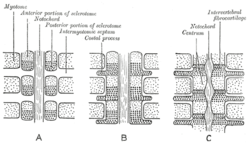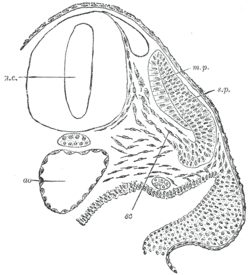- Myotome
-
Myotome Scheme showing the manner in which each vertebral centrum is developed from portions of two adjacent segments. (Myotome labeled in upper right.) Transverse section of a human embryo of the third week to show the differentiation of the primitive segment. ao. Aorta. m.p. Muscle-plate. n.c. Neural canal. sc. Sclerotome. s.p. cutis-plate. ("Muscle-plate" is an older term for "myotome.") Latin myotomus Gray's subject #17 80 Carnegie stage 13/14 Precursor somite Gives rise to muscle Code TE E5.2.0.0.0.0.6 In vertebrate embryonic development, a myotome is a group of tissues formed from somites that develop into the body wall muscle.
Each myotome divides into a dorsal epaxial part and a ventral hypaxial part.
The myoblasts from the hypaxial division form the muscles of the thoracic and anterior abdominal walls.
The term "myotome" is also used to describe the muscles served by a single nerve root.[1] It is the motor equivalent of a dermatome.
Each muscle in the body is supplied by a particular level or segment of the spinal cord and by its corresponding spinal nerve. The muscle and its nerve make up a myotome.[2]
The epaxial muscle mass loses its segmental character to form the extensor muscles of the neck and trunk of mammals. In fishes, salamanders, caecilians, and reptiles, the body musculature remains segmented as in the embryo, though it often becomes folded and overlapping, with epaxial and hypaxial masses divided into several distinct muscle groups.
Contents
Clinical Significance
Myotome testing can be an integral part of neurological examination as each nerve root coming from the spinal cord supplies a specific group of muscles. Testing of myotomes, in the form of isometric resisted muscle testing, provides the clinician with information about the level in the spine where a lesion may be present.[3] During myotome testing, the clinician is looking for muscle weakness of a particular group of muscles. Results may indicate lesion to the spinal cord nerve root, or intervertebral disc herniation pressing on the spinal nerve roots.
Myotome distributions of the upper and lower extremity are as follows;[4][5]
- C1/C2-neck flexion/extension
- C3-neck lateral flexion
- C4-shoulder elevation
- C5-shoulder abduction
- C6-elbow flexion/wrist extension
- C7-elbow extension/wrist flexion
- C8-thumb extension
- T1-finger abduction
- L2-hip flexion
- L3-knee extension
- L4-ankle dorsi-flexion
- L5-great toe extension
- S1-ankle plantar-flexion
- S2-knee flexion
See also
References
- ^ myotome at eMedicine Dictionary
- ^ Apparelyzed: Myotomes & Dermatomes
- ^ Magee, David. J (2006). "1". Orthopaedic Physical Assessment (4th ed.). St. Louis: Elsevier. pp. 1–63. ISBN 978-1-4160-3109-3.
- ^ Magee, David. J (2006). "3". Orthopaedic Physocal Assessment (4th ed.). St. Louis: Elsevier. pp. 121–181. ISBN 978-1-4160-3109-3.
- ^ Magee, David. J (2009). "9". Orthopaedic Physocal Assessment (4th ed.). St. Louis: Elsevier. pp. 467–566. ISBN 978-1-4160-3109-3.
External links
Embryology of bones, joints, and muscles (GA 2.80, TE E5.0-2) Ossification Lower limbHeadcranium: Ossification of occipital bone · Ossification of frontal bone · Ossification of temporal bone · Ossification of sphenoid · Ossification of ethmoid
facial bones: Ossification of vomer (Sutura vomerina · Foramen vomerinum · Meatus vomerinus · Fissura vomerina) · Ossification of maxilla · Ossification of mandibleOtherOther M: JNT
anat(h/c, u, t, l)/phys
noco(arth/defr/back/soft)/cong, sysi/epon, injr
proc, drug(M01C, M4)
Categories:- Embryology
- Neurology
- Developmental biology stubs
Wikimedia Foundation. 2010.


